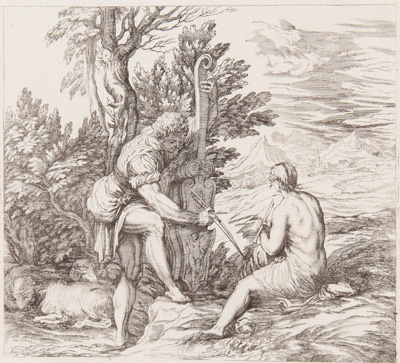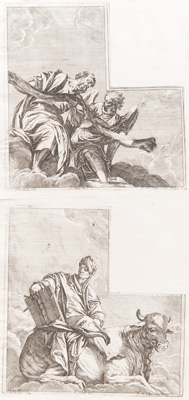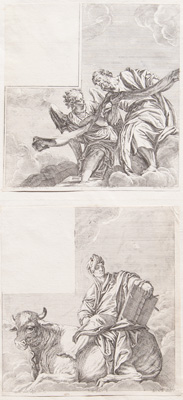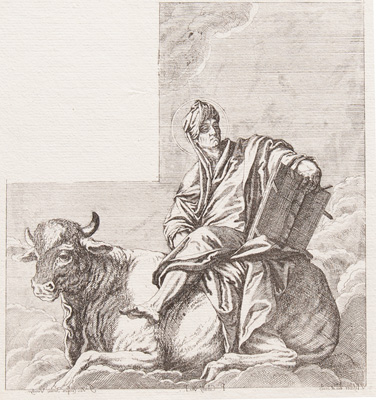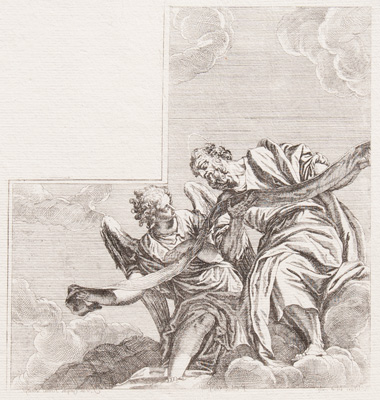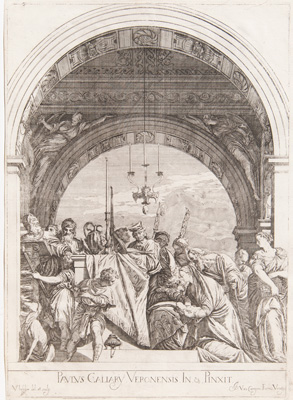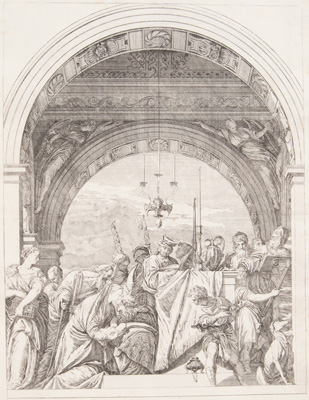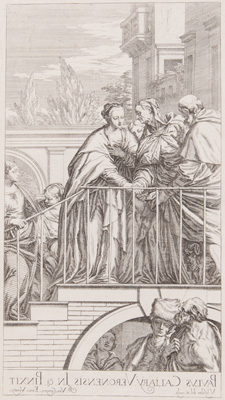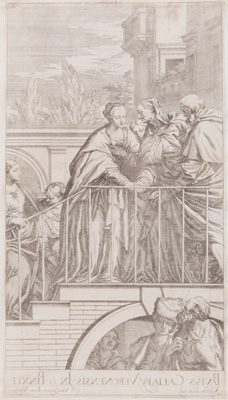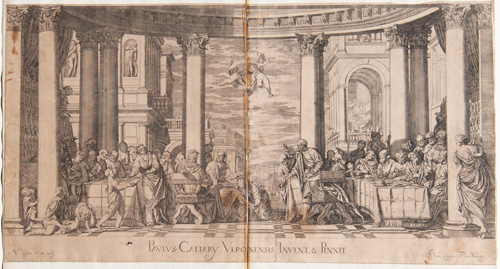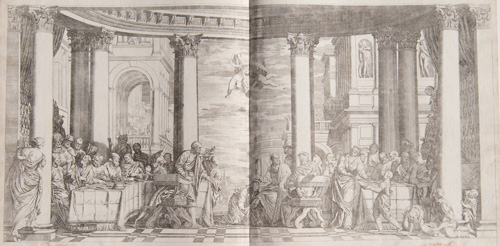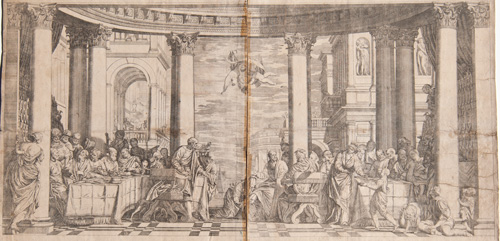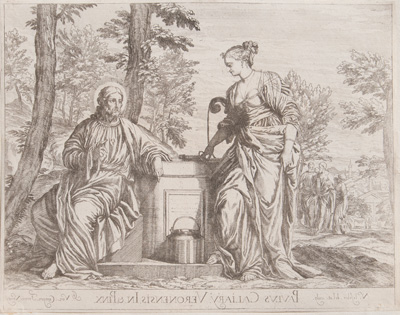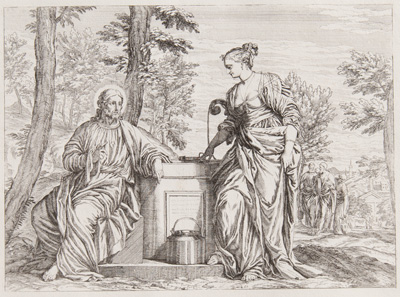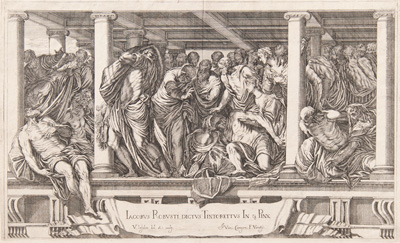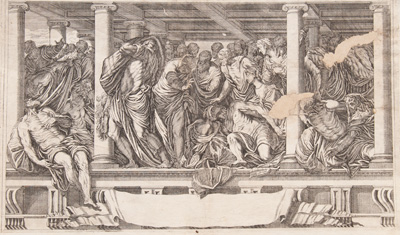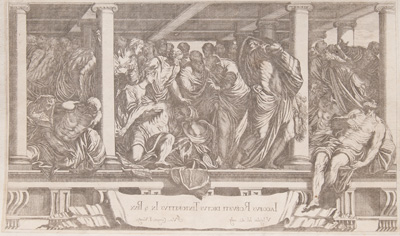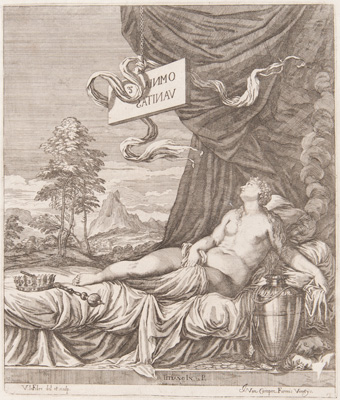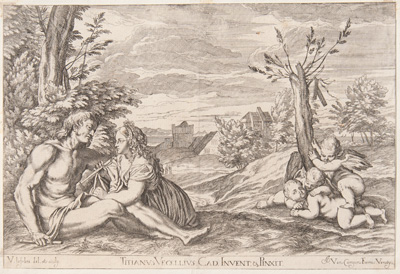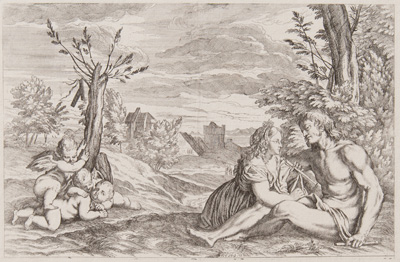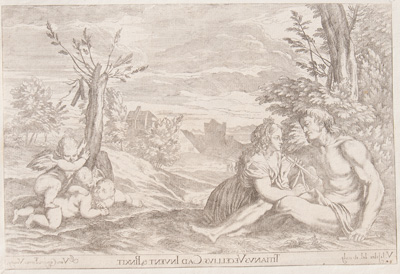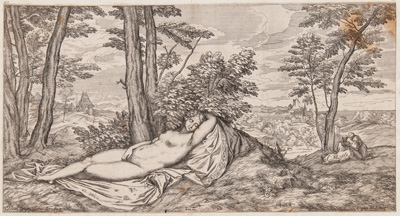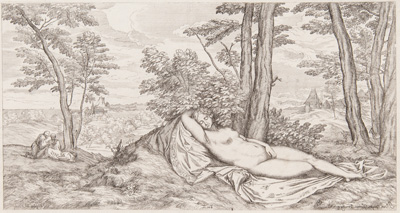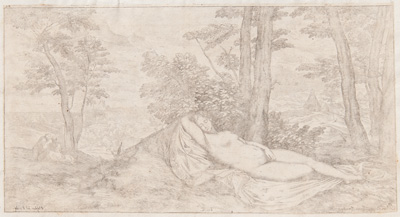Opera Selectiora Quæ Titianus Vercellius Cadubriensis, Et Paulus Calliari Veronensis Inventarunt Ac Pinxerunt, Quæ Que Valentinus Le Febre Bruxellensis Delineavit, Et Sculpsit: Christianissimo Ludovico magno Franciæ, Et Navarræ Regi Invictissimo. Sacrat, Vovet Iacobus Van Campen
Interestingly, there are 3 versions of each etching: the final version with lettering and attribution; a reversed proof (counterproof) before lettering and attributions; and another counterproof (also reversed, but with the lettering and attributions in reverse) pressed on India paper or chain-laid paper then laid down on the handmade chain-laid paper. Since the counterproofs are made from a fresh "regular" proof, they tend to be quite a bit lighter. See link above for definition of counterproofs. Original etchings, 340 years oldSheet size: varies slightly, but approximately 15 3/4 x 22 1/4 inches (approx. 40 x 56.5 cm), chain-laid paper |
||||||||||||||||||||||||||||||||
|---|---|---|---|---|---|---|---|---|---|---|---|---|---|---|---|---|---|---|---|---|---|---|---|---|---|---|---|---|---|---|---|---|
 |
|
|
||||||||||||||||||||||||||||||
|
|
 |
||||||||||||||||||||||||||||||
 |
|
|
||||||||||||||||||||||||||||||
|
|
|
||||||||||||||||||||||||||||||
|
|
|
||||||||||||||||||||||||||||||
|
|
|
||||||||||||||||||||||||||||||
 |
|
|
||||||||||||||||||||||||||||||
|
|
|
||||||||||||||||||||||||||||||
|
|
|
||||||||||||||||||||||||||||||
|
|
|
||||||||||||||||||||||||||||||
|
|
|
||||||||||||||||||||||||||||||
 |
 |
|||||||||||||||||||||||||||||||
|
Original Antique and Vintage Masterpiece Art prints Antique and Vintage Religion/Mythology prints
|
||||||||||||||||||||||||||||||||
BIOGRAPHIES OF TITIAN, VERONESE, AND TINTORETTO (Source: www.theartstory.org) |
||||||||||||||||||||||||||||||||
Titian(Tiziano Vecelli, 1488/90–1576) Who Was Titian?Titian became an artist's apprentice in Venice as a teenager and worked with Sebastiano Zuccato, Giovanni Bellini and Giorgione before branching out on his own. Titian became one of Venice's leading artists around 1518 with the completion of "Assumption of the Virgin." He was soon creating for works for leading members of royalty, including King Philip II of Spain and Charles V, the Holy Roman Emperor. Pope Paul III also hired Titian to paint portraits of himself and his grandsons. Early LifeBorn Tiziano Vecellio in what is now Pieve di Cadore, Italy, sometime between 1488 and 1490, Titian is considered one of the greatest painters of the Italian Renaissance. The oldest of four children born to Gregorio and Lucia Vecellio, Titian spent his early years in the town of Pieve di Cadore, near the Dolomite mountains. In his teens, Titian became an apprentice to the Venetian artist Sebastiano Zuccato. He soon went work with such leading artists as Giovanni Bellini and Giorgione. Giorgione proved to be especially influential to the young painter. Major WorksIn 1516, Titian began work on his first major commission for a church called Santa Maria Gloriosa dei Frari in Venice. He painted "Assumption of the Virgin" (1516-1518) for the church's high altar, a masterwork that helped establish Titian as one of the leading painters in the area. He was known for his deft use of color and for his appealing renderings of the human form. A short time after completing the legendary altarpiece, Titian created "The Worship of Venus" (1518-1519). This mythology-inspired work was just one of several commissioned by Alfonso I d'Este, duke of Ferrara. Titian managed to cultivate a broad range of royal patrons during his career, including King Philip II of Spain and Holy Roman Emperor Charles V. Titian's Venetian home was a mecca for many of the community's artistic types. He had an especially close friendship with writer Pietro Aretino. Aretino is said to have helped Titian get some of his commissions. Sculptor and architect Jacopo Sansovino was another frequent visitor. Over the years, Titian created portraits of leading figures of the day. He painted two works featuring Pope Paul III between 1545 and '46, and spent six months living at the Vatican while making these paintings. In 1548, he traveled to the court of Charles V, where he painted his portrait as well. In his later career, Titian focused more on religious and mythological works. For Spain's Philip II, he painted "Venus and Adonis" (c. 1554), a piece inspired by Ovid's "Metamorphoses" that shows the goddess Venus trying in vain to hold on to her beloved Adonis. Titian again explored his fascination with the Roman goddess of love in "Venus and the Lute Player" (1565-1570). Death and LegacyTitian continued to paint until his death, on August 27, 1576, in Venice. He reportedly died of the plague. The same illness had claimed the life of his son, Orazio, a few months later. His other son, Pomponio, sold his father's house and its contents in 1581. Some of the artwork there can now be found in museums around the world, including the Hermitage in St. Petersburg, Russia, and the National Gallery of Art in Washington, D.C. Through the wealth of works he left behind, Titian has inspired countless generations of artists. Rembrandt, Diego Velázquez, Antoon van Dyck and Peter Paul Rubens are just a handful of painters who were influenced by the great Venetian artist. |
Paolo Veronese(born Paolo Caliari, 1528–1588) Childhood and Early TrainingThe youngest of five siblings, Paolo Caliari, nicknamed Veronese after his birthplace, was born in 1528 in the Italian city of Verona, then a mainland province of the Republic of Venice. His father, Gabriele, was a stonecutter; his mother, Catherina, the illegitimate daughter of a nobleman called Antonio Caliari. He was born moreover in Verona's artists' quarter in the district of San Paolo, which may well have accounted for his parents' choice of Christian name. Paolo initially apprenticed under his father which meant he went for a time by his professional name too: Paolo Spezapreda ("Paolo the Stonecutter"). However, while working with his father, Paolo's precocious talent for drawing became apparent and, aged 14, his apprenticeship was transferred to the studio of a local master named Antonio Bandile (he would later marry Bandile's daughter). It is suggested in some unconfirmed accounts that he may have studied simultaneously in the workshops of Giovanni Francesco Caroto, from whom, he may have inherited his fascination with the application of color. Veronese's talent soon saw him exceed the standards usually demanded of Bandile's students. He had already moved away from the naturalistic tones of the High Renaissance and started to develop his own preference for a more colorful, more expressive, palette. He assisted Bandile with altarpieces in 1543 and 1544 and sections of these works would already bear his signature style. Having seen Veronese's work on the altarpieces, Michele Sanmicheli, the architect of many important buildings in Verona, provided Veronese with his first important commission working on frescoes for the Palazzo Canossa (1545-46). Veronese moved briefly to Mantua in 1548 where he made the acquaintance of Giulio Romano, Raphael's principle pupil and assistant, and one of the pioneers of the Mannerist style, a style well suited to Veronese's penchant for painterly elegance. Veronese created frescoes in the city's Duomo (Roman Catholic Cathedral) before he left for Venice in 1552. Mature Period1553 was an important year for Veronese. Not only had he relocated to Venice, but his father died. He took the name Caliari from his mother in the hope that this would afford him greater access to the Venetian aristocracy, while he used the name "Veronese" predominantly for signing purposes and to draw attention to his place of birth. Working in Venice allowed him to take advantage of the new demand for Venetian painting stirred by the likes of Giorgione, Titian, and Tintoretto. Following in their esteemed footsteps, Veronese quickly received commissions from governing bodies including the Hall of the Council of Ten and confraternities like San Sebastiano. It is unusual to talk of a painter's "Mature Period" starting in their mid-twenties. But such was Veronese's talent even Giorgio Vasari, author of newly published The Lives of the Most Eminent Sculptors, Painters, and Architects (1550), was taken by the fact that someone so young could have already made such an illustrious career for himself. Indeed, Veronese's first Venetian commission was his Sacra Conversazione (Holy Conversion) for the San Francesco della Vigna church in 1552. This was followed in 1553 by his first state commissions: ceiling paintings for both the Hall of the Council of Ten (Sala dei Cosiglio dei Dieci) and Doge's Palace (Palazzo Ducale), the latter being the supreme seat of power for the Venetian republic. He followed with a History of Esther in the ceiling for the church of San Sebastiano and further works in the Ducal Palace and the Marciana Library sealed his standing as a Venetian Master. Late periodVeronese soon began receiving patronage from powerful aristocratic families such as the Barbaro family for whom he decorated the Villa Barbaro (their stately home near Maser). In the latter part of the 1550s, Veronese decorated the villa of Venice's most renowned architect Andrea Palladio. The collaboration between artist and architect was widely regarded as a triumph of art and design and Palladio would later describe Veronese in his Four Books on Architecture (1570) as "the most excellent painter". For his part, Veronese referenced their professional ties by including Palladian buildings in his great masterpiece, The Wedding at Cana (1563). Meanwhile, Veronese continued to work (as did Tintoretto) on restorations at Doge's Palace (Palazzo Ducale) during the 1560s and 1570s following a succession of serious fires. Veronese married Elena (Bandile's daughter) in 1566, welcoming their first of five children (fours sons; one daughter) in 1568. Veronese's mother Catherina had also moved to Venice by this time. Though a decade of great uncertainty for Venice, Veronese consolidated his status and strong family ties during the 1570s. In 1571, as part of the Holy League (that being a league comprised of the great Catholic maritime powers) Venice defeated the Ottoman Empire and Veronese named his only daughter, Vittoria, in honor of this victory in 1572. The resultant Counter Reformation, which saw a great resurgence in Catholic culture, was beginning to bring its influence to Venice. There was now less demand for erotic or mythological works and Veronese was called on to produce smaller devotional paintings. Between 1574 and 1577 major fires and plagues afflicted Venice (the plague claiming Titian in 1576) and Veronese began investing his substantial wealth in land and property. By the 1580s he had established a workshop with his sons and brother Benedetto and while initially the quality of the studio's work was considered uneven (at best), the workshop eventually began producing great works independently of its Master's hand. Veronese, who, incidentally had reverted to his proper name Paolo Caliari in 1575, died from pneumonia in 1588 and was buried in the Church of San Sebastiano, surrounded by his artistic contributions to the church. The Legacy of Paolo VeroneseFor at least a decade after his passing Veronese's family used sketches and drawings to complete more works from the studio signed under the name "Heirs of Paolo" while prints of Veronese's work were in high demand even during his own lifetime; something highly unusual for a living artist at that time. This allowed for his Mannerist style to be transported and admired far beyond its time and place of origin. Art historian Clare Robertson links Veronese for instance to the important French artist Eugene Delacroix, whose Liberty Leading the People (1830) utilises dramatic lighting and references contemporary architecture in the manner of the Veronese tableau The Wedding at Cana. Xavier F. Solomon, author of the National Gallery's catalogue on Veronese, meanwhile, has linked him to Flemish Baroquepainter Peter Paul Rubens through his focus on narrative and luminous color as seen in works like The Descent from the Cross (1612-14). It is also known that Diego Velázquez, acquired Veronese's Venus and Adoni(c.1580) at some point during his trip to Italy between 1649 and 1651, and, through an intricate composition of figures set in a rigid architectural setting, Veronese's influence can be traced in works such as Las Meninas (1656). It is known too that in 1797 Napoleon had thought so highly of The Wedding at Cana(1563) that he ordered his troops to roll up the canvas and transport it to Paris. It eventually took its place in the Louvre opposite the Mona Lisa where it was admired, not only by Delacroix, but also by the poet Charles Baudelairewho was moved enough to write about Veronese's "heavenly, afternoon colors."
|
Tintoretto(born Jacobo Robusti, 1518–1594) Childhood and EducationThere are few details known about the childhood and early life of the Italian artist Tintoretto. Born Jacopo Robusti, even the year of his birth is unclear with scholars placing it sometime in either 1518 or 1519. He is known to have come from Venice, however, making him one of the few iconic artists of the Venetian School to have been born in this city. His father, Giovanni Battista Robusti, was a cloth dyer; an occupation which would influence his son's artistic style surrounding the young Jacopo with colors, pigments, and other artistic mediums virtually from infancy. This trade also provided the inspiration for the name he would ultimately adopt, according to art historian Stefania Mason, he "...proudly declared the family connection with dyeing when he adopted the nickname by which he remains best known - Tintoretto, 'the little dyer' - as seen in his signature on paintings as well as various documents." Early TrainingAlthough no definitive records exist, it is generally believed that Tintoretto's training began sometime in his early teens with a brief stint as an apprentice in the workshop of the famed Venetian painter, Titian. This association did not last long with many speculating it was due to a strong clash of personalities between the old master and the more progressive exuberant and boundary-pushing personality of the young pupil. Largely self-taught after this experience, Tintoretto would continue to develop his skills in part through making paintings on furniture. In Italy, at the time, there was a great demand for cassoni or ornate chests decorated with paintings, and it is here that Tintoretto is believed to have developed his distinctive approach characterized by rapidly executed loose brushwork often appearing sketch-like and, at times, incomplete. In his book, "Tintoretto: Tradition and Identity," art historian Tom Nichols writes, "In a number of small-scale paintings attributable to his earliest period, Tintoretto radically abbreviates his treatment of form, the sketchy effect being reinforced by his employment of a limited range of broken tones, close to one another on the color scale [...] Works such as these were intended to adorn furniture, and support [early biographer Carlo] Ridolfi's report that Tintoretto associated with painters of this type who peddled their wares from temporary wooden booths set up in St. Mark's Square. Ridolfi tells us that it was in this public (but professionally marginal) context that Tintoretto first learned the 'method of handling colors' particular to the cassoni painters." Tintoretto's gestural style, although once fashionable with associations to the earlier master Giorgione, was by then equated with the lower ranking cassoni painters. This left Tintoretto out of favor with some of his fellow Venetian artists and patrons. The writings of the artist Giorgio Vasari, best-known today for his biographies of the Renaissance artists, illustrate just how radical Tintoretto's technique was to his contemporary audience. Vasari writes, "this master at times has left us finished work sketches so rough that the brushstrokes may be seen. Done more by chance and vehemence than with judgement and design." While this passage may read as critical, perhaps to show a preference for the internationally recognized, and considerably more polished technique, of Titian, another quote shows Vasari's admiration for the bravura of Tintoretto's brushwork, citing the younger artist as "the most extraordinary brain that the art of painting has produced." Mature PeriodFrom as early as 1538, there is evidence of Tintoretto having his own workshop and referring to himself as a professional working in Venice. From the outset, the young artist set himself apart from his former teacher Titian, despite the popularity of his rival's accomplishments. Tintoretto's interest in, and emulation of, Michelangelo's approach to painting was especially disagreeable to his former master. According to curators Robert Echols and Frederich Ilchman, as they wrote in the 2019 exhibition catalog, Tintoretto: Artist of Renaissance Venice, the young artist"...presented himself in the role of a challenger to the established tradition as embodied by Titian and identified himself instead with the newest ideas circulating in Venetian painting. In the early 1540s that meant emulating contemporary currents in Florence and Rome, and above all Michelangelo, the biggest name in all of Italian art. [...] While the concept of an avant-garde painter aiming for 'the shock of the new' was not one articulated in the sixteenth century, Tintoretto was positioning himself on the cutting edge of Venetian painting." Unfortunately, Titian never forgave what he considered Tintoretto's disrespect and attempted on numerous occasions to thwart the younger artist's advancement by blocking Tintoretto's success in obtaining commissions and membership in various organizations. Despite Titian's disapproval, Tintoretto began to make a name for himself, first through a series of public works in the form of mural fresco paintings. He was able to gain work through charging extraordinarily low fees, often only covering the cost of materials, to gain exposure to a larger audience. This strategy proved successful, as Tintoretto began gaining commissions, including many religious works for which he would remain best known, including multiple depictions of the Last Supper, the first of which he created in 1547. Arguably it was his first masterpiece, The Miracle of the Slave, (1548) that brought him to the attention of the larger Venetian public and patrons and, in effect, launched his career. As Tintoretto began to prosper professionally, he also flourished in his personal life. He became friends with many of the leading literary figures of the day. Then, around 1550 he married Faustina Episcopi whose father was affiliated with the Scuola Grande di San Marco confraternity for whom he had created a painting. They would have eight children; three of whom would become artists. In addition to church commissions, a major source of employment for Tintoretto and other Venetian painters during the 16th century was for confraternities or scuolas. These organizations played a large role in the cosmopolitan Venetian culture, organized around a variety of purposes ranging from national origin to acts of public service, such as helping the ill and poverty-stricken. Over time, these scuolas acquired great wealth from their affluent members which provided a major source of patronage for the Venetian artists. Although Titian managed to block some of these commissions from Tintoretto, including from the Scuola Grande di San Rocco which Titian secured for himself in 1553, he never actually completed the assignment. Despite this occasion, Tintoretto was able to skillfully navigate the competitive process from which he benefitted greatly throughout his career. In fact, Tintoretto seemed destined to face challenges by other artists despite how impressively his reputation grew. The second major competition came in the form of Paolo Veronese who arrived in Venice in the late 1550s. Art historians Echols and Ilchman describe the impact of Veronese as"...unofficially but publically recognized as Titian's successor, as the older artist presented him with a golden chain for having executed the best ceiling painting for the reading room of Jacopo Sansovino's Libreria Marciana - a competition from which Tintoretto had humiliatingly been excluded. With this coveted position as the next leader of Venetian painting seeming to slip through his fingers, Tintoretto had to contend not only with Titian's machinations but with the undeniable talent of Veronese." Rather than concede defeat, Tintoretto persevered and strengthened his status by focusing on works characteristic of his style that set him apart from the more traditional approaches of Titian and Veronese. In so doing he made increasingly dramatic works, densely populated with figures creating rhythmic contrasts in light and dark that appeared more Mannerist than Renaissance in style. Tintoretto often employed questionably ethical means to secure coveted commissions, at times reducing the fee for his paintings enough to undercut other artists. The most notorious example of his strategic ingenuity centered around a competition for a ceiling painting for the new meeting house of the Scuola Grande di San Rocco in 1564. The prospectus from the confraternity called for selected artists, including Tintoretto, to submit a sketch for the proposed ceiling painting. Tintoretto, rather than providing a sketch, unveiled his completed panel, already installed on the ceiling. When others objected, he presented the painting as a donation, knowing that the confraternity would be obligated to accept a gift. The strategy worked, and by promising to render all additional paintings for the house for an annual salary of 100 ducats, the artist secured an exclusive contract with numerous commissions over the following two decades. Tintoretto was also admitted into the confraternity in 1565, where he would go on to hold various offices. Tintoretto was only known to have left Venice once to travel to Mantua, at the age of 62, in 1580. This was four years after the death of his rival, Titian, who had of all the Venetian painters, dominated the international stage. It was during this later period that Tintoretto also received a few important international commissions including an altarpiece for King Philip II of Spain and four works for the Holy Roman Emperor Rudolf II. He also painted an increasing number of non-religious themed paintings during this time. In these later years, he also created portraits and received many commissions from the Venetian state. One of the most notable being his creation of the large-scale painting, titled Paradiso, in 1592 for the Ducal Palace. As he neared the end of his life, Tintoretto increasingly relied on the help of his studio assistants to finish his paintings, including Paradiso. Most notable of those assistants were three of his nine children: daughter Marietta and sons Domenico and Marco. The artist was devastated when his oldest daughter, whom he lovingly nicknamed 'la Tintoretta,' died during childbirth in 1590. Just four years later, Tintoretto died fifteen days after contracting a fever. His sons would continue the work of his studio for many years, perhaps still under the guidance of those words Tintoretto had inscribed on its wall years before: Il disegno di Michelangelo e il colorito di Tiziano (The drawing of Michelangelo and the coloring of Titian). The Legacy of Jacopo TintorettoJacopo Tintoretto left an indelible mark on 16th-century Venetian painting and beyond. His unique approach to artmaking with rapid, loose brushstrokes and strong contrasts between light and dark deeply challenged the traditional style of the iconic master Titian, Paolo Veronese, and his Venetian contemporaries. His bold compositions offered an alternative style to the hierarchal staging of the traditional Renaissance paintings. Because of this, Tintoretto is often associated with the Mannerist painters of the later Renaissance period. His influence, however, was felt long after his own time. Tintoretto's highly dramatic, almost theatrical compositions would serve as inspiration for the development of the 17th-century Baroque art movement. The impact of his gestural style, notable for its obvious traces of his brushwork, reverberates in the passionate style of Diego Velázquez and Peter Paul Rubens. His early self-portrait, dated to 1548, is considered a precedent to those of later artists including Rembrandt; while the contemplative mood of his much later self-portrait, was described by the modernist icon Edouard Manet as "one of the most beautiful paintings in the world."Tintoretto's influence continues to permeate the world of painting, impacting contemporary artists most notably in the grand, expressionistic aspects of his compositions. According to Echols and Ilchman, "in our time, such painters as Emilio Vedova, Anselm Kiefer, and Jorge Pombo have specifically measured themselves against Tintoretto, creating huge canvases filled with audacious brushwork and coloristic effects." |
||||||||||||||||||||||||||||||
|
Original Antique and Vintage Masterpiece Art prints Antique and Vintage Religion/Mythology prints
|
||||||||||||||||||||||||||||||||




